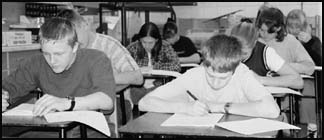 Over 150 students in Paynesville took the statewide basic standards tests in reading and mathematics last week. The reading test was held on Tuesday morning, Feb. 2, and the mathematics test was on Thursday, Feb. 4.
Over 150 students in Paynesville took the statewide basic standards tests in reading and mathematics last week. The reading test was held on Tuesday morning, Feb. 2, and the mathematics test was on Thursday, Feb. 4. The tests are part of the graduation standards required by the state and were taken by the eighth grade class, which has 101 members, and any ninth, tenth or eleventh grader who has not passed the test already. This is the fourth year of testing, and the current juniors will be the first to graduate under its requirements.
ďI think the test went very well,Ē said Marilyn McCollar, the eighth grade English teacher. ďThe students took it very seriously.Ē
ďIím very pleased with how seriously they (took) the test,Ē agreed middle school principal Deb Gillman.
The reading test required students to read nonfiction articles, maybe from newspapers or magazines. Then they answered multiple-choice questions asking about the main ideas or supporting information. Some questions asked students to distinguish between opinion and fact.
For both English and mathematics, the eighth grade students studied and did practice tests in advance. McCollar stressed a strategy of reading the questions before the story. She thought this helped students pick out the important information and was amazed by the number of students who used this strategy on the test.
The math test on Thursday focused on areas emphasized by the state: estimation, percentage and ratio, number sense, whole numbers and fractions, chance and data, measurement, tables and graphs, and shape and space. It was an 80-point multiple-choice test.
Murry Rafferty, the eighth grade mathematics teacher, said the test is for minimum competency and some students breezed through it. Others struggled a bit, and he had tried to identify some problem areas during review and concentrated on these.
The math test consisted largely of story problems, and some students with reading difficulties had the math test read to them.
Security during the test was strict, as was the security of the test papers, which were all coded and immediately returned to the state.
The test was not timed. ďWe set aside two hours,Ē said Gillman, ďbut we made arrangements for any (student) who needed more time and they finished it.Ē
ďReally the key to doing well on it is to take your time, to not rush when you read through, and to go back into the article and look when youíre not sure,Ē said Danith Clausen, the school districtís curriculum director, about the reading test.
Clausen organized the test and said they held the test right away in the morning so kids could take it with fresh minds.
Clausen said 66 students in the high school had to take the reading test and 50 needed to pass the mathematics test. In the middle school, the tests were mainly held in their homerooms, but special arrrangements needed to be made in the high school to get the kids who needed to take it into designated rooms for the tests.
Clausen said the results will be out in the spring. Those who do not pass will need to retake the test either in the summer or next year. Last year, the state offered an optional testing date in the summer, and Paynesville took part.
ďOur results have been okay,Ē said Clausen, ďbut thereís room to get better.Ē In the high school, they offer special classes in reading and basic math skills. Last year they also had a summer school program. ďWe have put in place ways to assist those kids,Ē said Clausen.